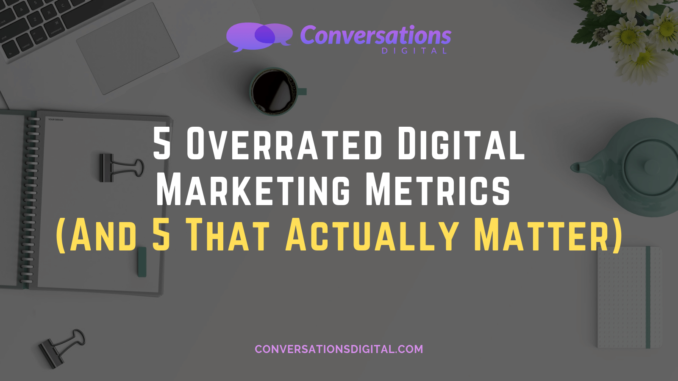
Good digital marketing companies supply data to their clients. When sourced correctly, this data can help measure the success of internet marketing campaigns, but it’s important to remember one thing: while metrics are helpful, not all data is created equal. Make sure you’re taking a comprehensive look at how your metrics impact your business.
Here’s a rundown of overrated digital marketing metrics and how some underrated sources of data might help you make sense of whether your efforts are actually improving your business.
1. Overrated: Overall Website Traffic
Following the traffic on your website is a helpful statistic in that it provides a window into your website’s overall performance. That being said, overall website traffic isn’t the only metric needed to determine a website’s success. For instance, local businesses might be receiving high traffic, but this traffic is coming from places beyond that business’ service area. If a business relies solely on serving its proximate community, a slew of visitors from other states and countries isn’t beneficial. Additionally, not all a website traffic is human-generated. Upticks in traffic could be the result of search engine indexing bots or worse, spammers.
If your business relies mostly on local clientele (e.g. a dental practice, a small boutique, or a lawyer’s office) it’s important to look at local and source traffic. Local traffic signifies the number of visitors coming from your region, while source traffic conveys what search engines and platforms brought visitors to your site. For example, source traffic details whether a visitor manually typed in your URL or whether he or she came from various social media platforms and search engines.
2. Overrated: Bounce Rate
Bounce rate is a popular metric that some digital marketing agencies use to measure the effectiveness of your website’s ability to draw in potential customers. This marketing metric catalogs how many pages a user visited on your website after a search engine brought them to a particular web page. Simply put, a bounce rate indicates how many people left your site after only visiting one page. High bounce rates might indicate that your site, for whatever reason, isn’t appealing, while low bounce rates can signify that your content and design are engaging.
While bounce rates can be helpful at evaluating your digital marketing strategy’s effectiveness, they won’t give you the whole picture. For example, bounce rates don’t relay important information such as how long a person visited your website. They also can’t reveal whether that single-page visit led to a phone call to your business. Simply put, there are other metrics to consider to gauge your users’ experiences on your website.
A better metric to pay attention to is the visit-to-lead conversion rate. Since a bounce rate can’t tell the entire story, knowing how many visits to your website triggered lead action (such as filling out web forms) help you to measure the effectiveness of your digital marketing efforts.
3. Overrated: Phone Calls, Clicks, and Click-Throughs
Sometimes a “click” is counted as lead. While clicks can convert to leads and sales, not all clicks are created equal. Moreover, not all phone calls to your business generate leads. A lead should be defined as an action that a potential client or customer makes that brings your business closer to making a sale. Phone calls and clicks could be the result of people looking for employment and business to business sales. Similarly, if you keep track of phone calls to your business it’s important to exclude calls that relate to personal matters, employment queries, wrong numbers, existing clientele, and robotic calls.
Instead of relying solely on clicks and overall calls to your business, consider measuring user actions like filling out web forms or other calls to action. It also doesn’t hurt to ask (and keep track of) potential clients/customers how they heard about your business.
4. Overrated: Rankings
A website’s rankings refer to whether a website or its pages show up in the first few pages of results returned from a search engine. While it’s important to have a good ranking on Google, Bing, and Yahoo!, there are other metrics to consider. As mobile search and local search generate traffic and leads from communities, a website’s overall ranking isn’t as important as it used to be. For instance, a high ranking could be bringing in visitors beyond your service area. So, while top rankings for the keywords “family law attorney” are helpful, keywords specific to your locale like “Denver family law attorney” might yield more lead generation.
While your website’s rankings are important, if your overall revenue is not increasing on a consistent basis, this metric is likely not as valuable as some digital marketing agencies would have you believe. Keeping an eye on your revenue is an essential element of measuring the effectiveness of your marketing strategy.
5. Overrated: Cost Per Click
Pay per click (PPC) is a form of search engine optimization (SEO) that generates traffic to your website based on advertisements. Advertising is tailored to a web user’s entries into search engines. While PPC can generate traffic, the costs can fluctuate. don’t always equate to having a better value. Sometimes, advertising with higher CPC can lead to increased sales because they draw quality traffic to your website.
When evaluating CPCs, it’s important to look at the return on your marketing investment (ROMI). Are your sales increasing? Have you generated more leads since initiating your PPC strategy? If so, your marketing efforts are working. As long as you’re generating more business beyond your marketing budget, higher CPCs might be worth your investment.
Our digital marketing agency serves diverse businesses throughout the United States. If you need help making sense of the ever-changing world of digital marketing, give our team of experts a call. We tailor our marketing solutions to our clients’ unique needs.
